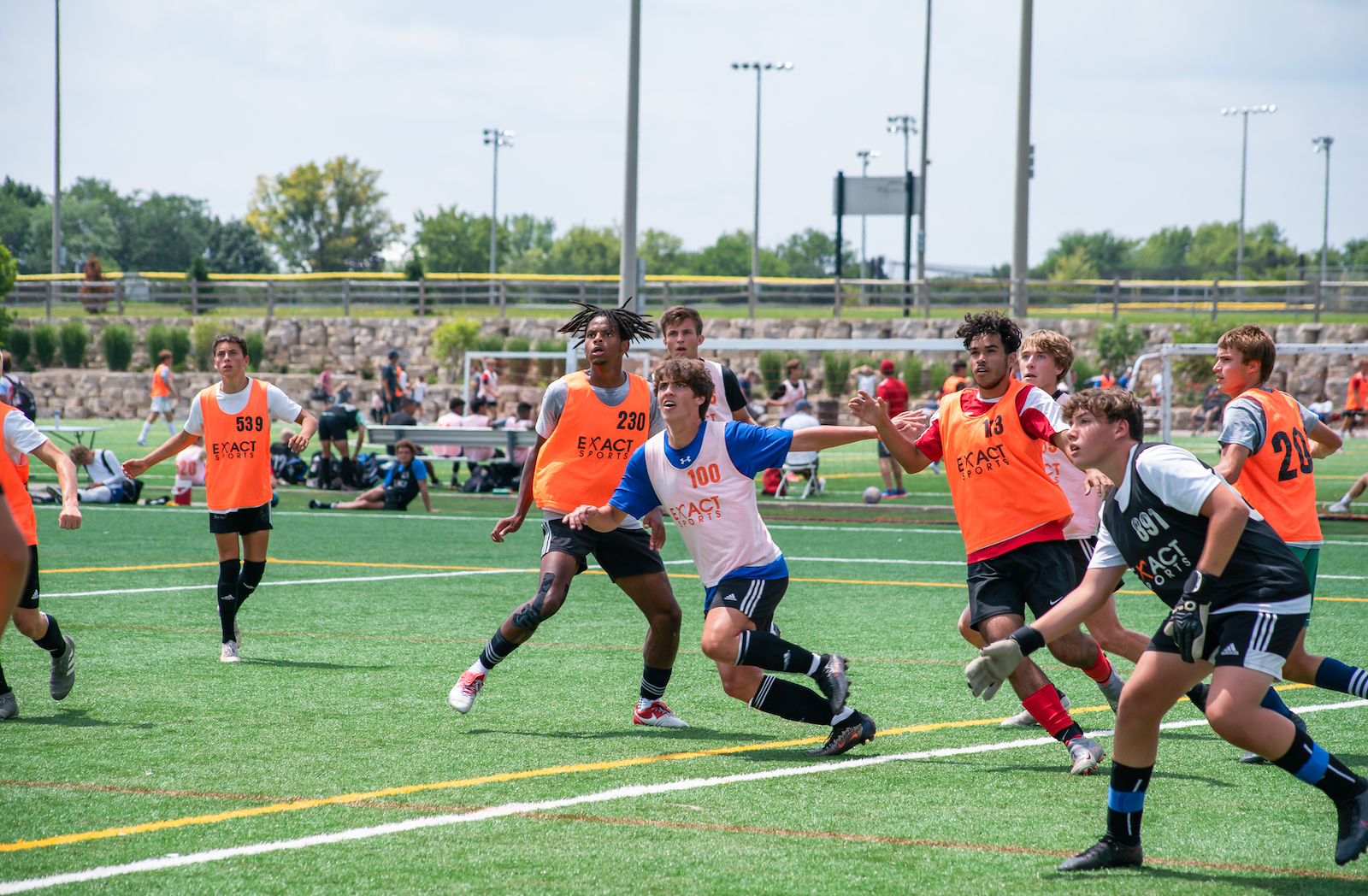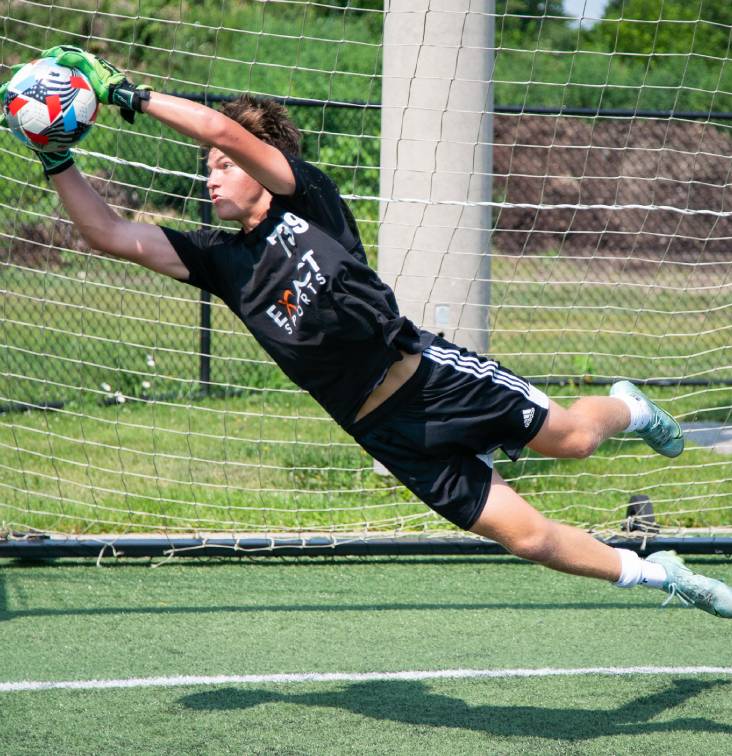
College Coach Instructs a team of elite young soccer players at an EXACT Soccer college showcase camp.
How To Increase Stamina On The Field
Player stamina is a key piece of your performance as a young soccer athlete especially when you are in the college recruiting process and attending college id camps where college coaches are watching you play against other top-tier athletes.
Here are a few quick tips on how you can increase your stamina on the field:
- Shuttle Runs: Shuttle runs are among other popular speed endurance soccer drills that coaches use to train speed, acceleration, and anaerobic fitness.
- Stop and Go Soccer Endurance Drills: The reason why you want to add this workout to your soccer fitness training program is that it simulates exactly what your players do during the game.
- Speed Hill Sprints: Sprinting on a hill is the kind of workout activity that combines strength and speed to give you stronger and faster players.
- Dribble and Run: This activity is fairly simple because it’s meant for starters. But you can combine it with other soccer agility drills to make it more challenging as your players’ experience increases.
- Planks: A vital role of core workouts is to train the muscles around the abdomen, pelvis, lower back, and hips. These are crucial muscle groups as they improve balance and stability.
1 v 1 Dribble Drill
Advanced dribbling skills can be very useful especially for wide players. Wide players must be able to beat their opponent down the wing and still have enough time to cut inside, to shoot, to square the ball, or to get to the end line to deliver a cross for the forwards to attack. When a winger run rings around the opposition it can lift the whole stadium and create positive energy throughout the whole team.
Agility Cone Exercise
Dribbling through cones is a great way to learn ball control in close a quarters environment. Place five cones about 5 yards apart in a straight line for 20 yards. Starting at Cone 1, sprint with the ball to Cone 2. Turn and sprint back to Cone 1, turn and sprint to Cone 3, back to Cone 1, and so on. Once you have reached all four cones and are back at Cone 1, take a 55-second rest before starting the next set.
Circle of Cones Drill
To start this drill, place cones in a circle that is about five yards in diameter and pick one cone as your starting point. Get in an athletic position, and when ready or upon a cue from the coach, run around the circle as fast as possible while controlling the ball. When you reach the original starting cone, break away from the circle and run straight for five yards to end the drill.
One-Touch Shooting Exercises
A great team practice drill where you set up two cones at the top of the 18 yard box directly across from the posts. Split the team in half with a line at each post. The first player on one side runs around the cone directly in front of them and receives a pass from the opposite line which they must finish with one touch. As soon as the player on the opposite side makes their pass, they start their forward run. Players switch lines after every shot. Normally in the drill, the first three players to score five goals win.

A group of top-tier high school athletes compete at an EXACT National Soccer College Showcase Camp.
Three Goal Drill
You will need half of a field with a full-size goal. Set two portable goals on each sideline about 15 yards from midfield. Position a goalkeeper in each of the three goals. The rest of the team starts at midfield, and each player has a ball. Place the remaining balls at each of the three goals.
- The first player in line dribbles toward the right sideline goal and takes a shot on goal.
- The keeper then distributes the ball to the outside of the cone towards the primary goal.
- The shooter receives the ball from the keeper and shoots on the primary goal.
- The next keeper then distributes the ball to the outside of the cone towards the left goal.
- The shooter receives the ball from the keeper and shoots on the left goal.
- The keeper then distributes the ball around the cone towards midfield.
- The shooter receives the ball and dribbles to midfield to the back of the line.
- The next player in line starts once the goalkeeper on the right side distributes the ball to the shooter.
Lay Offs Control
If you have another player working with you on this drill, have that player pass the ball from 10 yards away. You control the pass, lay if off to their correct foot, communicate to them they have time and they run up and shoot it or make a pass to empty space. Do 10 reps and switch with your dill partner.
If you don't have a drill partner, you can use a wall or a fence and kick the ball off of the surface. As it comes back to you control it, then lay it off to an imaginary teammate running on to it. Do 10 reps, rest and repeat until you feel good.

Aspiring college athlete trains with a nationwide network of D1, D2, and D3 college coaches at an EXACT National Soccer Showcase Camp.
Drive Ball Drills
- Cross Bar Challenge. Players compete by driving the ball from the top of the penalty box and try and hit the crossbar.
- Scud Missile Practice.Two players each have a ball and try and collide them in the air by coordinating a driven ball.
- Mannequins. Players drive the ball over the mannequin to a player who has spun behind the mannequin. That player receives the ball and moves to the next area for driving the ball.
- Squares. Players stand in a coned zone – say 6 yards by 6 yards – 20 yards from each other ( or adjusted to player’s capabilities.) Players drive the ball to their drill partners. If the ball lands in the square and the player in the square can control it and keep it in the square with 1 touch, the players get a point.
One Touch Passing
Set up a square on the field about 25 yards wide and place two players at each corner. One player starts with the ball while the other player makes a run to the center of the square to receive and makes a one touch pass out to the third player. Player 1 follows the pass into the center to receive from Player 3. Players continue to pass and follow into the center or out of the center as the ball moves clockwise around the square. After about 10 minutes, the drill should change direction.
Pressuring Drills
Here is a 2v2 +2 drill that enables players to understand the concepts of pressing and covering with plenty of opportunities for repetition. Regular transitions will also introduce the principle of delaying and the idea of recovery runs.
Place to mini goals at each end of the area. Players are split into teams of two, with one team acting as neutrals. The two neutral players position themselves one at each end, between the mini goals. The other two pairs play 2v2 in the middle of the area, and can only score by receiving a pass back from one of the neutral players. Play first to two goals, the winning team stays on and the losing team switch with the neutral players.
Defensive Header
The defensive header is different than a goal scoring type of header. The aim of the defensive header is to clear the ball from danger. This means heading it high, hard, and as far away from the danger zone as possible. In this situation, power is often more important than pinpoint accuracy. A well-placed defensive header, however, could also lead to a counter attack.
Here's an advanced defending crosses drill:
Use the penalty area, extending the area to about 30 yards out. There should a total of 9 Players with two defenders, a goalkeeper and three attackers. On the right and left hand side of the 18 yard area are two servers and another server in front of the penalty area, about 25 yards out. The servers are numbered, can move to vary the angle of serve and must serve the ball by throwing it. The coach calls which server will throw the ball to give the defenders and goalkeeper time to set themselves. The defenders and goalkeeper defend the crosses and the attacker tries to score.
Small-Sided Game Drill
A great team drill for 15 players. Set up a 50×40 yard grid using small cones. Place a full-size goal at each end of the grid. If you don’t have full-size goals, use tall cones, flags, or whatever you have available. Have a supply of balls available at the halfway line to help facilitate quick restarts. You’ll also need three sets of different colored bibs.
One team will have ten attacks total to score as many goals as possible. An attack is over when one of the following three things happen:
- The ball is kicked out of play.
- A goal is scored by the attacking team.
- The defending team makes a successful pass across the halfway line to the team defending the opposite goal.
